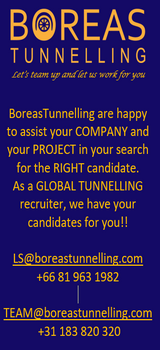Gateway Development Commission Awards Palisades Tunnel Project, First Tunnel Boring Contract
Board Also Approves Start of Hudson River Ground Stabilization Project Phase Two
Newark/New York – The Gateway Development Commission (GDC) Board of Commissioners today
awarded the Palisades Tunnel Project contract to Schiavone Dragados Lane JV. This is the first
tunnel boring contract GDC has awarded for the Hudson Tunnel Project (HTP). Work on the
Palisades Tunnel Project will begin in the coming months and is expected to be completed in 2027.
The Board also approved the authorization of a Notice to Proceed for Phase Two of the Hudson
River Ground Stabilization (HRGS) Project, the first heavy construction project of the HTP. Phase
One of the HRGS Project began in May and is expected to conclude this fall. Phase Two will be
completed in 2027.
In a joint statement, Alicia Glen, New York GDC Commissioner and Co-Chair, Balpreet Grewal-Virk, New Jersey GDC Commissioner and Co-Chair, and Tony Coscia, GDC Amtrak Commissioner and Vice Chair, said, “When we signed the full funding grant agreement for the Hudson Tunnel Project in July, we said that construction would ramp up quickly. Today we are following through on that commitment with dramatic steps forward for our first heavy construction and tunnel boring projects. Advancing both of these projects is a major step in the construction phase of the HTP, and we will maintain the disciplined process that enabled this achievement.”
GDC CEO Kris Kolluri said, “Securing full funding for the Hudson Tunnel Project brought us to the point of no turning back. With the Board’s actions today, we complete the transition from planning this tunnel to building it, and we could not be off to a stronger start. I am thankful for our many partners in Washington, New York, and New Jersey who have worked with us to get to this point and for the GDC team whose hard work enabled us to lock in these contracts on time and within budget.”
The Palisades Tunnel Project will construct the first mile of twin-tunnels on the New Jersey side of the Hudson River. It includes boring two tunnels approximately 5,100-feet long with an inside diameter of 25 feet 2 inches and six cross passages, as well as furnishing and installing a concrete tunnel lining with waterproofing membrane. The project also involves building the new Hudson County Shaft, which will be used to remove the Tunnel Boring Machines when digging is complete.
Following a publicly advertised bidding process, proposals were reviewed by an Evaluation Panel consisting of technical experts and representatives from GDC, the State of New York, NJ TRANSIT, the Port Authority of New York and New Jersey (PANYNJ), and Amtrak. Schiavone Dragados Lane JV was selected through a competitive evaluation of technical and price proposals. The award the GDC Board approved today includes $465 million for the total contract price and an additional five percent of the contract price for contingencies.
The HRGS Project involves injecting a mix of soil, concrete, and water into the riverbed in 1,200 feet of the shallow area on the Manhattan side of the Hudson River to ensure the Tunnel Boring Machines can excavate the new tunnel and protect the riverbed from disruption. To limit impacts on the river ecosystem, temporary sheet pile cofferdams will enclose the work zone and construction will be timed to avoid disrupting fish spawning seasons.
Phase One of the HRGS Project included surveying and the design and construction of a test cofferdam. Phase Two will include injecting grout into the silt on the riverbed to create columns of soil mixed with cement and water that will stabilize the ground above the future tunnel.
The GDC Board awarded the contract for the HRGS Project to Weeks Marine, Inc. in February following a publicly advertised bidding process and review by an evaluation committee of technical experts.
GDC Board approved today includes $465 million for the total contract price and an additional five
percent of the contract price for contingencies.
The HRGS Project involves injecting a mix of soil, concrete, and water into the riverbed in 1,200 feet
of the shallow area on the Manhattan side of the Hudson River to ensure the Tunnel Boring
Machines can excavate the new tunnel and protect the riverbed from disruption. To limit impacts on
the river ecosystem, temporary sheet pile cofferdams will enclose the work zone and construction
will be timed to avoid disrupting fish spawning seasons.
Phase One of the HRGS Project included surveying and the design and construction of a test
cofferdam. Phase Two will include injecting grout into the silt on the riverbed to create columns of
soil mixed with cement and water that will stabilize the ground above the future tunnel.
The GDC Board awarded the contract for the HRGS Project to Weeks Marine, Inc. in February
following a publicly advertised bidding process and review by an evaluation committee of technical
experts.
The Board also approved hiring William Fletcher to serve as Inspector General. The Inspector General reviews GDC’s policies and processes and recommends enhancements and preventive measures to minimize the risk of misconduct. Fletcher will also investigate complaints pertaining to fraud, waste, and abuse and administer and manage the Commission's whistleblower access and assistance program. He will prepare reports for the Commission's leadership and external entities as required. As mandated in GDC’s founding legislation, the Inspector General reports directly to the Board of Commissioners.
Fletcher brings over 20 years of professional experience to the role, with more than 13 years in various Offices of Inspector General, including serving as the Inspector General for the Chicago Board of Education, Inspector General for the Chicago Park District, Deputy Inspector General at the Chicago Board of Education, and Assistant Inspector General for the City of Chicago.
source Gateway Development Commission.
cover tunnel photo by: Matt Brown from London, England / CC BY
Copyright 2019-2024 TunnelContact.com







